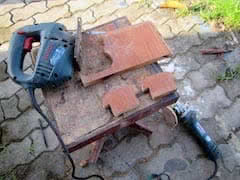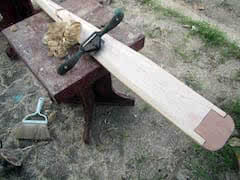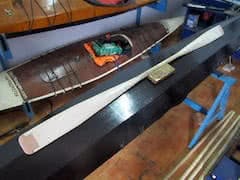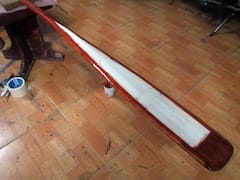 he first image: cutting two hardwood blocks to attach to the paddle’s 2 ends, 2nd image: scraping the paddle blades with a power planer and a spokeshave. 3rd image: the paddle takes its final shape, next it would be sanded, colored (stained with thinned epoxy), glassed then painted. The paddle would receive a layer of fiberglass all over the body, to waterproof the porous balsa wood, and to strengthen the whole structure.
he first image: cutting two hardwood blocks to attach to the paddle’s 2 ends, 2nd image: scraping the paddle blades with a power planer and a spokeshave. 3rd image: the paddle takes its final shape, next it would be sanded, colored (stained with thinned epoxy), glassed then painted. The paddle would receive a layer of fiberglass all over the body, to waterproof the porous balsa wood, and to strengthen the whole structure.
This is only the first of two paddles I’d intended to build. A lightweight Greenland paddle would be my convenient, all – round thing to propel the boat with. But under some particular circumstances, e.g: very strong wind or current, I would need a more powerful tool, that’s why my next one would be a paddle of the usual Euro type, it would be also very lightly built, and has much smaller blades, around 50 x 14 cm in dimensions.
I’ve not yet to really realize which paddle type is better: Greenland or Euro, but thought that they all has their uses in different situations, and decided to build and use… both. Also, my paddles all has become smaller and shorter, their lengths now are around 1.85 ~ 1.9 m. My thought is that sea – kayakers nowadays are using paddles that are longer than needed (around 2.2 m), especially those going for long touring.
I made a terrible mistake, using the wrong duct tape to mask the paddle for coloring. A kind of 3M duct tape is so sticky that it’s extremely hard to be removed after having painted the paddle blades with colored – thinned – epoxy. I seriously scratch the surface while removing the duct tape (with a chisel) resulting in a very poor finish on one blade 😢. The paddle would be perfectly usable, but not as good – looking as I’d expected.




